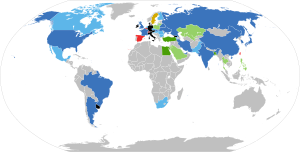Research topics
Articles general
- Corium - "Corium, also called fuel containing material (FCM) or lava-like fuel containing material (LFCM), is a lava-like molten mixture of portions of nuclear reactor core, formed during a nuclear meltdown, the most severe class of a nuclear reactor accident." - Wikipedia
- International Nuclear Event Scale - "There are 7 levels on the INES scale; 3 incident-levels and 4 accident-levels. There is also a level 0." - Wikipedia
- List of nuclear reactors - Wikipedia
- Nuclear meltdown - "A meltdown occurs when a severe failure of a nuclear power plant system prevents proper cooling of the reactor core, to the extent that the nuclear fuel assemblies overheat and melt. A meltdown is considered very serious because of the potential that radioactive materials could be released into the environment." - Wikipedia
- Nuclear power - "Nuclear power is produced by controlled (i.e., non-explosive) nuclear reactions. Commercial and utility plants currently use nuclear fission reactions to heat water to produce steam, which is then used to generate electricity.power" - Wikipedia
- Thorium fuel cycle - "The thorium fuel cycle is a nuclear fuel cycle that uses the naturally abundant isotope of thorium, 232Th, as the fertile material which is transmuted into the fissile artificial uranium isotope 233U which is the nuclear fuel." - Wikipedia
- What are the immediate health effects of exposure to radiation? - BBC - March 15, 2011
- Where are the world's nuclear reactors? - Short Sharp Science - March 18, 2011
For news about the Fukushima nuclear crisis see: The Fukushima nuclear crisis in Japan (some articles that were first published here are now listed there)
- The moment nuclear plant chief WEPT as Japanese finally admit that radiation leak is serious enough to kill people - Mail Online - March 19, 2011
- Harmless? Chernobyl Radiation Killed Nearly One Million People - prisonplanet.com - March 17, 2011
- How to Stop a Nuclear Meltdown - Time - March 12, 2011
- Chernobyl: It Will Never Be Over - "The latest scientific studies suggest that the damage to wildlife and fauna continue unabitated in and around the Chernobyl exclusion zone - and far beyond. Research recently concluded provides more evidence that contamination has a "significant impact" on biodiversity." - Infoshop News - August 25, 2010
- 25 Years After: Scenes from Chernobyl--The Worst Nuclear Accident in History [Slide Show]
- Holes from US nuclear tests
- Research topics: North Korea's nuclear power
- Research topics: Nuclear power - playlist
- How Nuclear Power Works
- MIT NSE Nuclear Information Hub - Scientific explanation of events related to nuclear crisis in Japan
- U.S. Nuclear Accidents




No comments:
Post a Comment